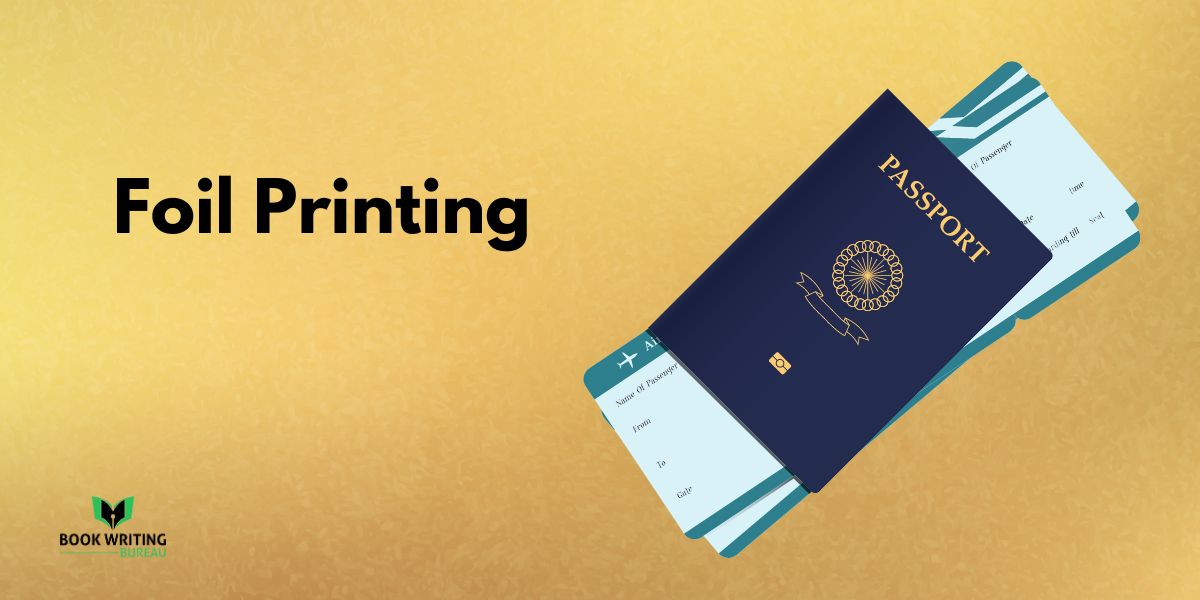
Printing
Foil printing, a technique that adds metallic or pigmented foil to various surfaces, has become a game-changer in the printing industry. From business cards to wedding invitations, foil work brings a touch of grace and sophistication to any project. This article will explore the world of foil work and how it helps your print projects.
What is Foil Printing?
Foil printing, also known as foil stamping or foil blocking, is a specialized printing process that adds a metallic or pigmented foil to various surfaces. Unlike traditional printing methods, foil work creates a shiny and reflective finish that adds a touch of sophistication and luxury to printed materials.
This process typically involves using a metal plate or a digital image to apply the foil onto the desired surface. The foil, available in various colors and finishes, adheres to the printed material through heat and pressure, creating a visually stunning effect. This is widely used for brand, logos and book promotion services such as business cards, invitations and packaging to enhance their aesthetic appeal and make them stand out.
How Foil Printing Helps Your Printing Projects?
Foil printing isn’t just about making things look pretty – it can make a big difference in your printing projects’ success. Adding foil to design a book cover creates a special look and feel that grabs people’s attention. Whether you’re working on book promotional materials or your stationery, here are some ways foil printing can take your project to the next level:
1- Looks Awesome:
It adds a touch of class and style that you might not get with regular printing. The shiny and reflective foil makes your designs stand out and catch the eye.
2- Improves Brand Image:
If you’re a business, using foil in your marketing stuff like business cards or packaging can make your brand look good. The fancy finish gives off a vibe of high quality and careful attention to detail.
3- Leaves a Lasting Impression:
When you use foil work, people tend to remember your stuff better. Whether it’s a fancy wedding invitation or a label on a top-notch product, the unique look and feel of foil-printed materials stick in people’s minds.
4- Works on Different Materials:
You’re not limited to paper – this can be done on many materials, like cardboard and fabric. This means you can get creative and use it for various industry projects. It gives you a lot of freedom to make things look cool!
What is the Difference Between Foil Stamping and Foil Printing?
“foil stamping” and “foil printing” are often used interchangeably, leading to confusion. However, key differences between the two processes are important to understand.
Foil Stamping:
- Traditional technique: Foil stamping is a traditional printing technique that has been in use for many years.
- Embossed or debossed: Foil stamping often involves creating a raised (embossed) or lowered (debossed) effect on the printed material.
- Limited colors: Foil stamping is typically limited to one or two colors per design.
Foil Printing:
- Modern Techniques: It has evolved and now includes various methods like hot foil stamping, cold foil stamping, and foil digital printing. Each technique has its unique characteristics and applications.
- Diverse Finishes: It offers a wide range of finishes to choose from. You can go for a metallic look, a matte finish, or a holographic effect. This versatility lets you pick the finish that best complements your design and overall project aesthetic.
- Multicolored Designs: Unlike traditional foil stamping, which is often limited to one color, this printing allows for incorporating multiple colors in intricate designs. This means you have more creative freedom to express your ideas and make your designs more vibrant and eye-catching.
How Much Does It Cost to Custom Foil Printing?
One common question when considering foil work is, “How much does it cost?” The cost of custom foil printing can vary depending on several factors:
Factors Influencing Cost:
- The technique can affect the cost, whether hot foil stamping, cold foil stamping, or l foil digital printing.
- The type and color of the foil chosen for the project contribute to the overall cost. Special finishes or holographic foils may incur additional expenses.
- The complexity of the design, including the number of colors and intricate details, can impact the cost of printing.
- Printing in larger quantities may provide economies of scale, reducing unit costs.
Comparisons Between Different Types of Foil Printing:
Hot Foil Stamping:
This traditional method can be more expensive due to metal dies and additional setup processes.
Cold Foil Stamping:
While it requires less setup than hot foil stamping, the cost can vary based on factors like foil type and design complexity.
Digital Foil Printing:
The cost can be more flexible as it eliminates the need for dies and allows more efficient handling of variable data.
How Digital Foil Printing Works?
You start with a digital design on a computer. Instead of special plates like in old-fashioned printing, a special ink with glue is applied to the paper where you want the shiny parts.
Next, the paper goes through a machine that heats up and presses it. This heat makes the glue stick to a thin, metallic or colorful foil. The foil is like a super-thin sheet with a cool design or color. The foil sticks to the paper when the heat touches it, creating a shiny effect.
The best part is that you can make each print unique because it’s done digitally. This method makes things like fancy business cards, invitations, or packaging look special. So, digital printing combines modern computer technology with the fun of making things look shiny and cool on paper!
Common Misconceptions About Foil Printing
Despite being a popular and attractive printing method, Foil work is often surrounded by misconceptions that can discourage people from using it. Let’s address some of these misunderstandings:
1- Affordability Concerns:
Some people think foil printing is too expensive. While it may cost more than regular printing, the perceived high cost is often due to the luxurious appearance it adds. It’s like buying a fancier version of a product.
2- Limited Design Options:
People may believe that foil printing limits design creativity. However, the foil application offers a wide range of possibilities. You can create intricate patterns and vibrant designs and combine them with other printing techniques for unique effects.
3- Difficulty of Use:
Some might think foil printing is challenging, but it’s manageable with the right equipment and knowledge. It’s like using a special tool for a specific job – it becomes easier once you get the hang of it.
Environmental Impact of Foil Printing:
Considering the growing importance of sustainability, it’s crucial to understand how this type of printing affects the environment. Here’s a straightforward look at this issue:
1- Eco-friendly Alternatives:
There are environmentally friendly options available for foil work. Using recycled materials and choosing eco-friendly foils can significantly reduce the environmental impact.
2- Responsible Practices:
Custom book printing services can adopt responsible printing practices, such as recycling waste and using energy-efficient equipment. This helps minimize the negative effects of foil printing on the environment.
3- Carbon Footprint:
It does have a carbon footprint, mainly due to energy consumption and material production. However, technological advancements and sustainable practices aim to make this impact as minimal as possible.
Foil Printing Trends in the Design Industry:
Some book cover designers opt for simplicity, using foil printing to accentuate minimalistic designs. It’s like adding a touch of luxury to a clean and simple canvas.
Others go for bold, vibrant designs, embracing foil’s reflective and eye-catching nature. This trend is like turning up the volume on your design, making it stand out with dazzling effects.
DIY Foil Printing: Is it Possible?
Achieving professional-looking results might require specialized equipment. However, for casual or small-scale projects, there are accessible DIY methods using readily available tools. While the results may not match those of a professional book printer in New York, satisfactory foil effects can still be achieved at home. Experimenting with different techniques and materials can lead to unique and personalized outcomes.
Conclusion:
Foil printing is a cool method to make your print projects look amazing. Whether you’re a business trying to leave a lasting impression or someone who wants to make personal projects look fancy, it’s important to know how printing works. There are different types of foil work and many ways to use it. You also need to think about how much it costs and what might become popular in the future. Overall, foil work opens up many exciting possibilities for anyone who wants a special and eye-catching printing experience.



